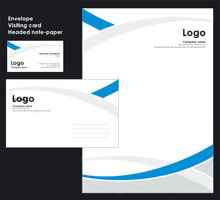 In marketing, a corporate identity is the "persona" of a corporation which is designed to accord with and facilitate the attainment of business objectives. It is usually visibly manifested by way of branding and the use of trademarks. Corporate identity comes into being when there is a common ownership of an organizational philosophy that is manifest in a distinct corporate culture — the corporate personality. At its most profound, the public feel that they have ownership of the philosophy. Often referred to as organizational identity, corporate identity helps organizations to answer questions like "who are we?" and "where are we going?" Corporate identity also allows consumers to denote their sense of belonging with particular human aggregates or groups.
In general, this amounts to a corporate title, logo (logotype and/or logogram), and supporting devices commonly assembled within a set of guidelines. These guidelines govern how the identity is applied and confirm approved colour palettes, typefaces, page layouts and other such methods of maintaining visual continuity and brand recognition across all physical manifestations of the brand. These guidelines are usually formulated into a package of tools called corporate identity manuals.
Many companies, such as McDonald's and Electronic Arts, have their own identity that runs through all of their products and merchandise. The trademark "M" logo and the yellow and red appears consistently throughout the McDonald's packaging and advertisements. Many companies pay large amounts of money for the research, design and execution involved in creating an identity that is extremely distinguishable and appealing to the company's target audience.
Organizational point of view
In a recent monograph on Chinese corporate identity (Routledge, 2006), Peter Peverelli, proposes a new definition of corporate identity, based on the general organization theory proposed in his earlier work, in particular Peverelli (2000). This definition regards identity as a result of social interaction:
- Corporate identity is the way corporate actors (actors who perceive themselves as acting on behalf of the company) make sense of their company in ongoing social interaction with other actors in a specific context. It includes shared perceptions of reality, ways-to-do-things, etc., and interlocked behaviour.
- In this process the corporate actors are of equal importance as those others; corporate identity pertains to the company (the group of corporate actors) as well as to the relevant others;
- Corporate actors construct different identities in different contexts.
Media and Corporate identity
As technology and mass media have continued to develop at exponential rates, the role of the media in business increases as well. The media has a large effect on the formation of corporate identity by reinforcing a company's image and reputation. Global television networks and the rise of business news have caused the public representation of organizations to critically influence the construction and deconstruction of certain organizational identities more than ever before.
Many companies proactively choose to create media attention and use it as a tool for identity construction and strengthening, and also to reinvent their images under the pressure of new technology. The media also has the power to produce and diffuse meanings a corporation holds, therefore giving stakeholders a negotiation of the organizational identity. |